
Types of Chef Hats
As part of a restaurant's dress code, chef hats are an important article of clothing to ensure sanitation in the kitchen and complete a chef's uniform. This guide will take you through the different types of chef hats and their purposes, from the traditional toque to an informal chef cap, so you can choose the best chef hats and headwear for your staff.
Shop All Chef Hats
Use the following links to learn more about the different types of chef hats:
Chef Hats
Chef hats are a type of hair restraint that are worn by chefs and cooks. While some chef hats are used to denote such as seniority in the kitchen, others serve a strictly functional role. Read on to learn more about the 9 different types of chef hats to decide which is best for your needs.

A toque chef hat is the most traditional of all chef's hats. It can look one of two different ways - either with a straight-sided base and a floppy, pleated top that comes in a variety of colors or as a tall, stiff, and pleated hat that is white. Traditionally, a toque hat is a symbol of seniority in the kitchen and is typically worn by the executive chef.
- Popular for use in upscale restaurants, catered events, and hotels to show a high-end, professional look
- Available in cotton, polyester, and poly-cotton blend materials
- Typically fastened with an adjustable self-fastening band to fit a variety of head sizes
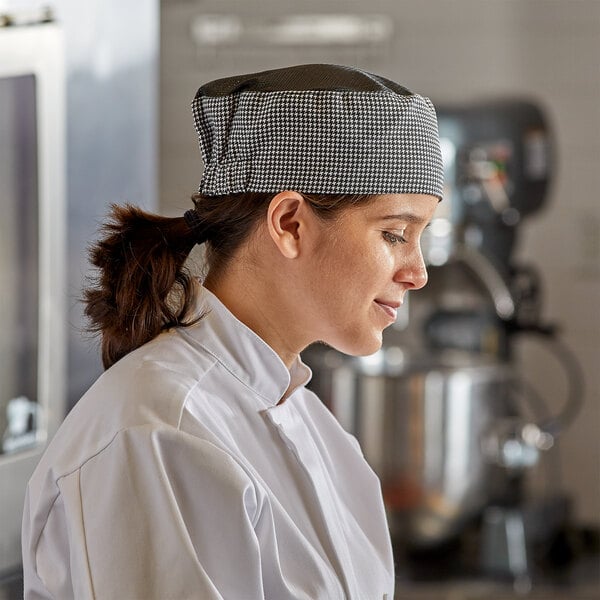
A chef skull cap, or pill box cap, is tight-fitting and lightweight, with many featuring a mesh top for enhanced air circulation in hot kitchens. It is less formal than a toque chef hat, yet still provides a professional, clean-cut look amongst kitchen staff, making it a great choice for modern and trendy eateries.
- Popular choice for bakers, pastry chefs, and line cooks
- Available in cotton, polyester, and poly-cotton blend materials
- Typically features an elastic band on the back to fit a variety of head sizes
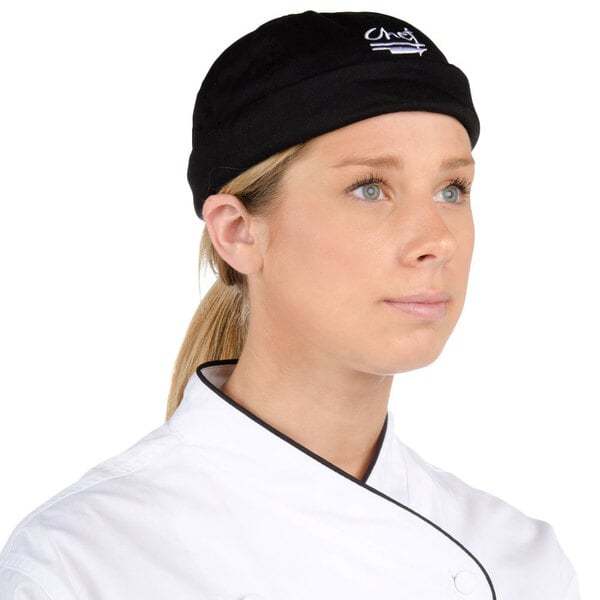
A chef beanie is a more informal type of chef headwear. It has a looser fit in comparison to a chef skull cap while remaining snug and flat to the head. The beanie is ideal for more casual eateries looking to supply their kitchen with comfortable, uniform headwear.
- Popular choice for line cooks, food prep cooks, and outdoor kitchens
- Available in a cotton material
- Typically features an adjustable self-fastening or elastic band on the back to fit a variety of head sizes

A baseball chef cap helps cover staff members' hair and keep an informal, yet professional appearance amongst your staff. They are made with absorbent and breathable materials that ensure comfort throughout long shifts. Their wide brims shade and protects eyes from bright overhead lighting or direct sunlight for added convenience.
- Popular choice for quick-serve restaurants, fast food restaurants, and food truck operators
- Available in cotton, polyester, and poly-cotton blend materials
- Typically feature a hook-and-loop back closure to fit a variety of head sizes

Chef berets offer a similar European style as the toque chef hat, but with less body to them. They are lightweight and feature small holes around the sides to keep the user cool while in a hot kitchen. Their design provides all-day comfort while helping to provide a clean, professional look.
- Popular choice for modern and upscale restaurants and cafes
- Available in poly-cotton material
- Typically feature an adjustable strap to fit a variety of head sizes
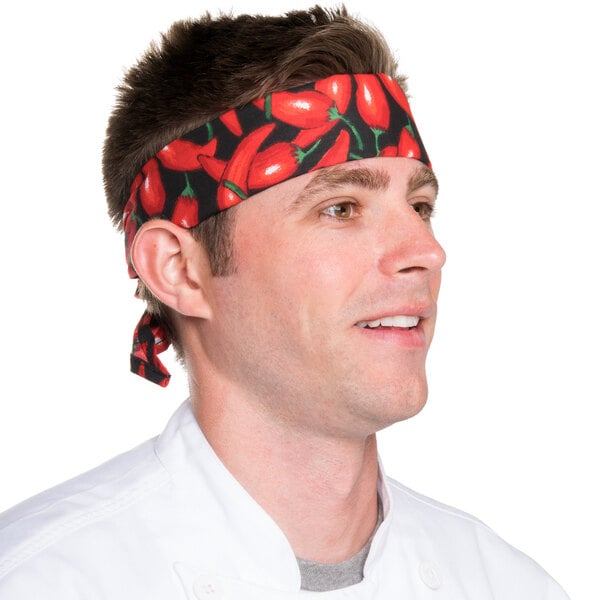
Chef bandanas and neckerchiefs absorb sweat to help staff stay cool in warm kitchens. Tie as a neckerchief to prevent sweat from dripping from the neck, or as a bandana to cover hair or protect the forehead from dripping sweat. While using it as a bandana presents as a more casual form of chef headwear, using it as a neckerchief can add a layer of sophistication and function to your chef's uniform.
- Popular choice for modern and casual restaurants, cafes, and food trucks
- Available in cotton, polyester, and poly-cotton blend materials
- Self-tie to fit a variety of head sizes
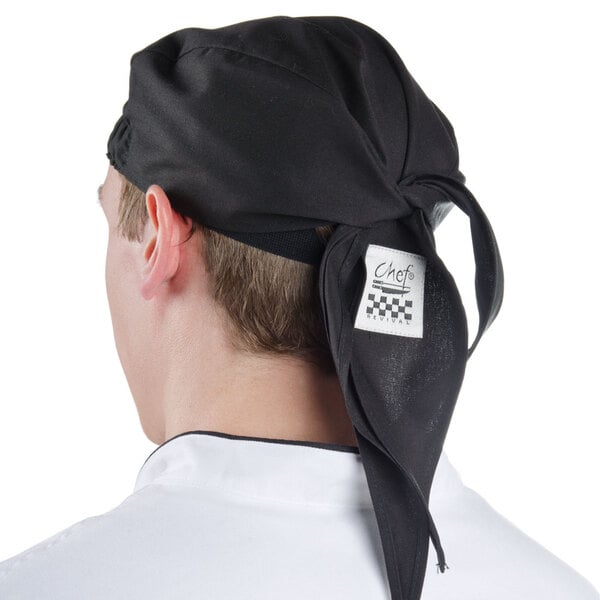
Chef headwraps are made with lightweight, breathable, and moisture-wicking fabric to ensure comfort throughout long shifts. Designed to provide comfort and function for chefs, headwraps are a great alternative to a traditional chef hat.
- Popular choice for quick-serve restaurants, fast food, and food trucks
- Available in a poly-cotton material
- Self-tie to fit a variety of head sizes

Chef headbands keep hair out of the face while cooking and are made with moisture-wicking fabric to absorb sweat. Many chef headbands can be used in multiple ways in addition to a traditional headband, including a do-rag, wrist band, hair tie, neck gaiter, or even a face mask.
- Popular choice for quick-serve restaurants, fast food, and outdoor kitchens
- Available in cotton, microfiber, and polyester materials
- Self-tie or elastic bands fit a variety of head sizes
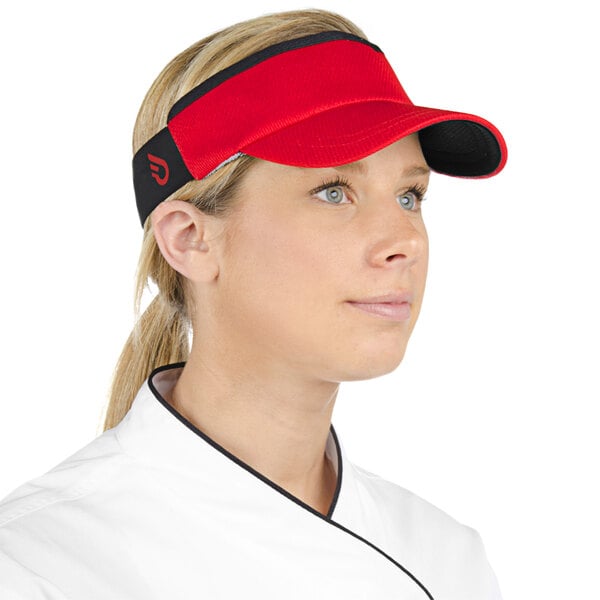
Chef visors are made with lightweight, absorbent materials to keep your staff cool and typically include a sweatband on the inside to help keep sweat off their faces. Visors are an informal type of chef hat and are a great choice for casual eateries and fast food. They can also help protect from sun glare, making them great for food truck operators, barbecue pit masters, and outdoor caterers.
- Popular choice for quick-serve restaurants, fast food, and outdoor kitchens
- Available in a polyester material
- Typically feature an elastic or hook-and-loop back closure to fit a variety of head sizes
Why Do Chefs Wear Hats?
To comply with health codes, chefs and other kitchen staff members wear hats to prevent hair and sweat from contaminating food. Not only does it help with hygiene and comfort, but it also establishes a professional, uniform look in your back-of-house.
Most modern kitchens today will opt for more informal or functional styles of chef hats to ensure their staff is kept cool and comfortable during their shifts. However, many fine-dining restaurant and hotel chefs will still wear the toque chef hat to keep the traditional, uniform look of a skilled chef and demonstrate their level of experience and expertise.
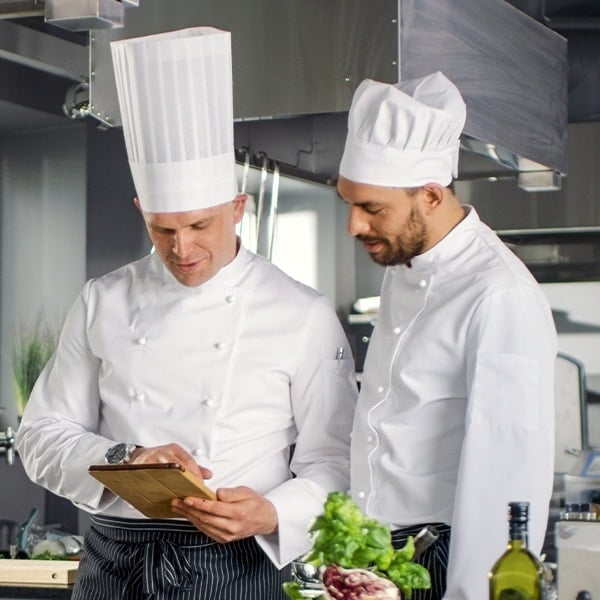
Why Do Chefs Wear Tall Hats?
Traditionally, the height of a chef’s hat denotes their experience and rank in the kitchen. Thus, the executive chef wears the tallest hat in the kitchen, and then the hats get shorter as you go down the hierarchy.
What Do the Pleats In a Chef Hat Stand For?
The origin of the number of pleats in a chef hat is similar to the height of a chef hat. When the toque hat was first created, it was said that the number of pleats in the chef's hat represented how many techniques or recipes that chef had mastered. For example, if the hat had 100 pleats, then that chef had mastered 100 recipes. In modern days, the number of pleats is generic and does not represent anything other than keeping the traditional look of the toque.
Chef Hat History
Two popularly-told stories highlight the main purpose of the chef hat's creation, which was to prevent cross-contamination from chef to food and establish a professional uniform.
According to one origin story, King Henry VIII required his chef and those who prepared his food to cover their heads after finding hair in his soup one day.
The popularization of the white toque hat in culinary tradition can be attributed to Marie Antoine-Carême, a French pastry chef from the 1800s. However, it wasn't until famed French chef, Aguste Escoffier, created an elevated look for trained chefs that included the tall, white, and pleated toque hat. Escoffier argued that chefs should wear professional uniforms, which included hats that varied in length to signify rank and easily identify positions within the kitchen brigade.
Back to TopRelated Resources

Workplace Hygiene
As many people return to working at restaurants, offices, warehouses, and as well as other establishments across the nation, it's imperative that proper workplace hygiene and thoughtful cleaning is taken into account. While disinfecting and sanitizing will help, employees must know how to handle themselves around other coworkers and customers as well. Here's how you can implement suggestions for necessary workplace hygiene. Proper Hand Washing By now, many people understand how to properly wash their hands to get rid of the most amount of germs. It's one of the most basic forms of workplace hygiene, and it's important to reiterate this information to your employees when they start back to work. Here are a few ideas on how to do that: Add th
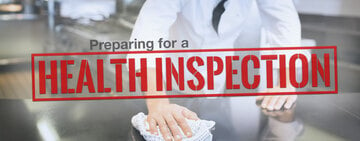
Preparing for a Health Inspection
Health inspections can be a frustrating and stressful experience, but it's important to remember that health inspectors don't come looking to shut down your operation. Health inspections are held to make sure food products are handled and prepared according to state and local regulations to protect the public. We created a restaurant health code checklist for you to follow so you can feel prepared for your next inspection. Use the links below to navigate through our health inspection tips: How to Prepare for a Health Inspection Health Inspection Checklist What to Do During a Health Inspection Understanding Health Inspection Scores Correcting Health Code Violations How to Prepare for a Health Inspection Ensure that your restaurant is ready f
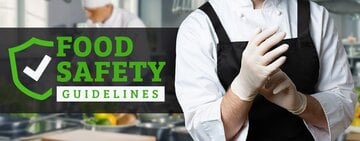
Food Safety Guidelines
Food safety guidelines are put in place to keep customers safe and prevent the risk of a foodborne illness outbreak. Any operation that serves food should establish protocols that meet the legal requirements for safe food handling. In this guide, we'll outline the most important aspects of food safety to help you build an effective program for your business and pass your next health inspection . Click below to learn about important food safety programs: Personal Hygiene Proper Food Handling Cleaning and Sanitizing Pest Control Purchase from Approved Suppliers Food Safety Training Food Safety Guidelines for Restaurants We'll cover the most important aspects of a successful food safety program so you can prevent a foodborne illness outbreak a
- Topics 1346
- Industrial 55
- Troubleshooting Guides 21
- Restaurant Management 128
- Bar Management 55
- Catering Tips 35
- Bakery Management 42
- Food Trucks & Concessions 49
- Advertising & Marketing 37
- Eco-Friendly Tips 11
- Facility Layout & Design 41
- Coffee Shop Tips 28
- Installation & Maintenance 51
- Janitorial & Pest Control 30
- Safety & Sanitation 88
- Startup Tips 104
- Menu Design 10
- Kitchen & Cooking Tips 81
- Hospitality Management 23
- Pizza & Sandwich Shop Tips 36
- Smallwares 37
- Food Prep 88
- Tabletop Items 17
- Disposables 22
- Calculators & Tools 6
- Consumables 52
- Warewashing & Laundry 18
- Cooking Equipment 90
- Food Storage & Refrigeration 51
- Beverage Equipment 34
- Office Supplies 6
- Resource Type
- In-Depth Articles272
- Buying Guides296
- How-Tos93
- Product Reviews77


